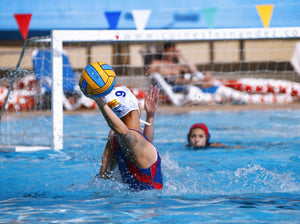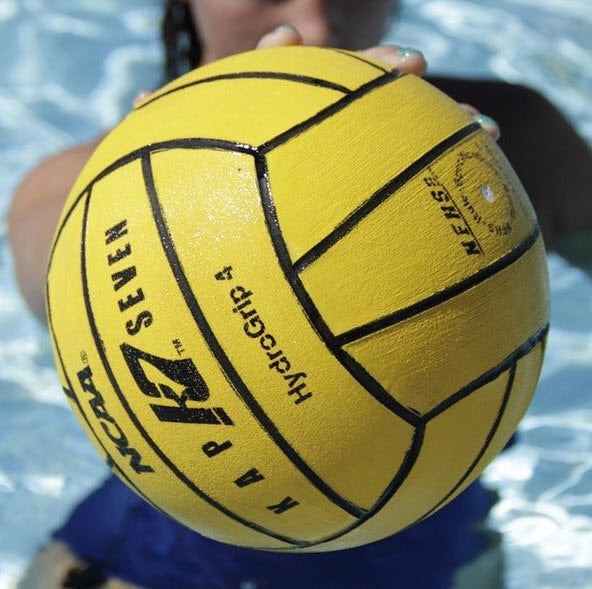Common Referee Calls & Signals in Water Polo
For players and spectators unfamiliar with the sport, a game of water polo can be very confusing — seemingly a mess of splashing, thrashing and whistle blows. However, once a few simple rules are understood it becomes an exciting and entertaining sport to watch. The easiest way to understand those simple rules is to take a look at how they’re policed by the referees.
Water polo referees are an important part of any water polo game, since they are in charge of monitoring the clocks, making calls, and controlling the inherent violence. This guide explains what referees do, and the most common signals and calls they use.
The Referee(s)
To help distinguish themselves from other people (players, coaches, photographers, spectators, etc.) standing on the edge of the pool, water polo referees dress in white from head to toe.
Ideally, each water polo game has two referees, one for each side of the pool. However, due to availability, cost, and pool design (not every pool can accommodate a referee on each side), it is not uncommon for one referee to monitor an entire game. However, water polo tournaments usually have multiple referees who work the games in various combinations so that one team does not always have the same referee(s).
Referee Calls & Signals
Water polo referees communicate mainly through whistle blasts and arm signals. The number of whistle blasts from a referee, the direction of their arms, and the numbers they convey to the desk all mean something different. There are a few calls that are repeated many times over the course of one water polo game, the most common of which are explained below.
Foul Calls
Fouls are a minor offense committed by one player. They result in a free throw for the opposing team, who has three seconds in which to make a pass before their defender can guard them again.
A foul call is announced with one whistle blast. The referee will point at the location of the foul with one hand, and toward the goal of the team who received the foul with the other hand. Below are some of the most common types of foul calls:
Exclusion Calls
An exclusion or "ejection" call is made for a more major offense, such as swimming over another players' back, or holding them intentionally. In this case, the offending player is ejected from the field of play for 20 seconds.
Exclusion calls are made with three short whistle blasts. The referee will then point to the player who committed the foul and then to the boundary of the pool or the ejection corner. Directly after that the referee will show the cap number of the player with their fingers for the desk and the field players.
Ball Under
If a ball gets pushed underwater, this results in a turnover. The referee will blow one whistle blast, press one hand down to mimic the "pushing" motion, and then point in the direction of the team with possession.
Holding, Head-butting, or Elbowing
The most common offensive fouls are holding, head-butting, and elbowing. Because it is rare for a foul to be called on an offensive player, the referee illustrates this by also forming the hands into fists (holding), jerking the head once (head-butting), or swinging an elbow back (elbowing). Offensive player fouls are rare since most fouls are the result of a defensive player going after an offensive player who has the ball.
Game Play Calls
Other types of calls focus specifically on the mechanics of the game itself. Here are some of the most frequently-used game play calls, and the situations in which they would be used:
Announcing a Goal
Referees will announce a goal has been scored by pointing one arm towards the net where the goal occurred and blowing the whistle one time. Directly after the call, they will signal the desk with their fingers the cap number of the scoring player.
Ball Out
It may seem obvious to always concentrate on the ball during the game, but in water polo there are usually lots of things going on simultaneously. Referees need to monitor every player, whether they have the ball or not. Learning to look at the entire field makes many calls easier to understand.
Sometimes a disputed or unclear call results in confusion in the water. To stop the play, consult with the desk or the other referee, or just to explain the original call, the referee will ask for the ball to be thrown out of the water. He or she will do this by making a circle with their hands that mimics the shape of the ball.
Game or Quarter Over
At the end of each quarter and game there is usually a long horn that sounds from the desk. If the desk does not have an electronic or air horn, the referee will blow one long, loud whistle blast while simultaneously crossing their arms in front of them and then swinging them straight out to the side.
Tip Out
If a goalie blocks a ball and it goes out of bounds, the ball returns to the team that took the shot as a free throw from the two-meter line in front of the offending goalie. The referee will blow the whistle once, sweep the fingertips of one hand over the other hand , and point to the two-meter line where the free throw should take place.
Refereeing is Important
Officiating a water polo match can be very trying, as a referee is responsible for handling multiple duties at the same time:
- Keeping track of what goes on underwater
- Constantly monitoring player actions
- Watching the rapid movement of the ball
- Handling/ignoring comments from the coaches, players, and spectators on deck
They're also often criticized for making unfair or incorrect calls during the game (as most sports officials are). However, their role is undeniably important: Without their supervision, the game would quickly deteriorate into a free-for-all of wrestling, grabbing, and yelling. Learning the basic referee calls above will lead to a better understanding of water polo, and a greater appreciation for the job of the referee.



